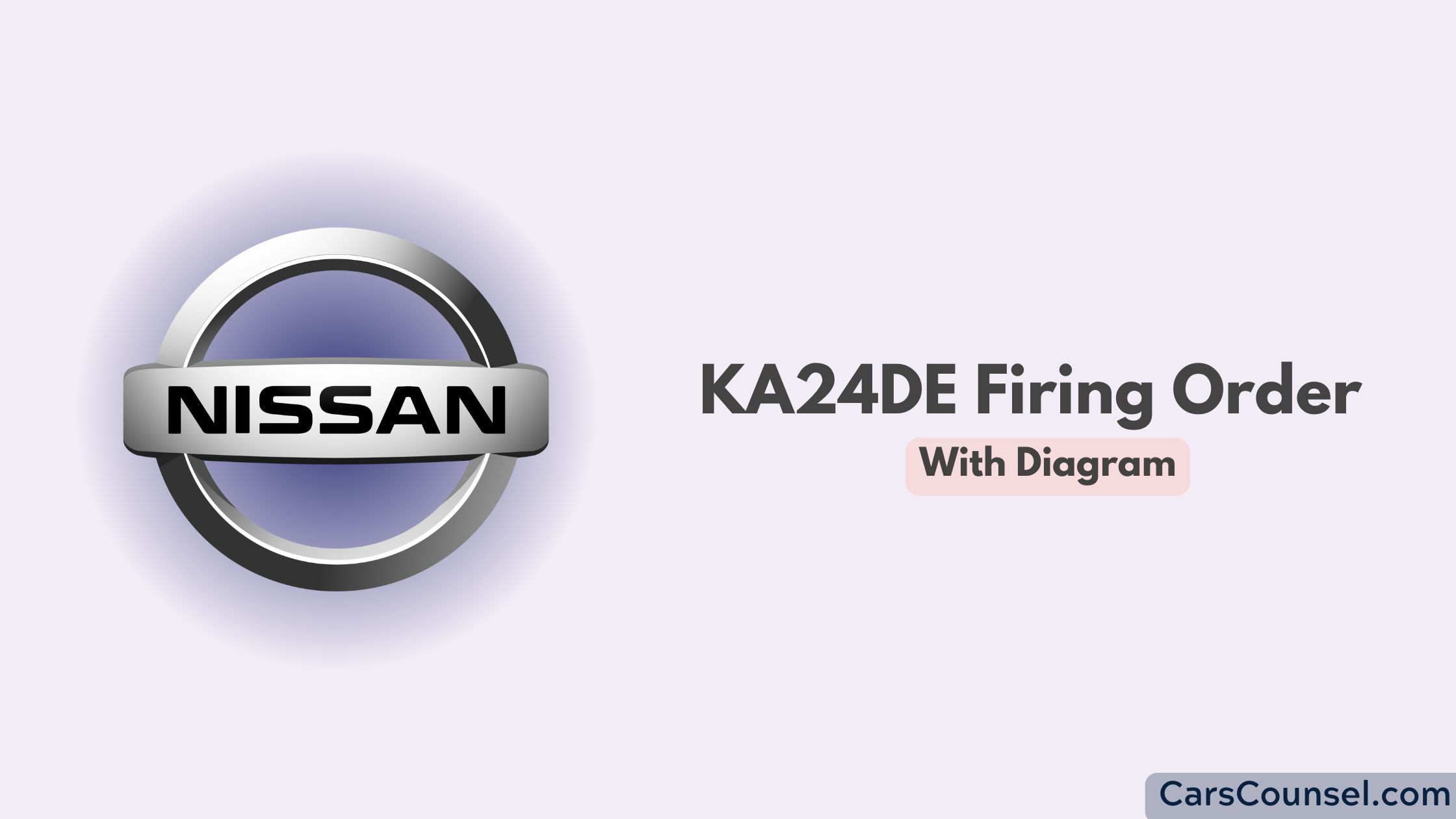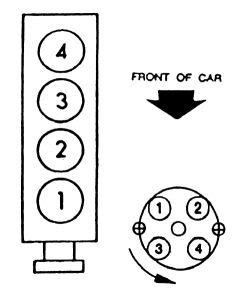The KA24DE engine, a 2.4-liter inline-four powerhouse from Nissan, is a fan favorite among car enthusiasts. Known for its durability, simplicity, and potential for modifications, this engine powers vehicles like the Nissan 240SX and Nissan Frontier.
Central to its operation is the firing order, which ensures proper combustion and smooth performance. In this guide, we’ll explore the KA24DE’s firing order, explain why it matters, and offer practical tips for maintaining it.

Quick Navigation
What is a Firing Order?
The firing order is the sequence in which the engine’s cylinders ignite their air-fuel mixture during the combustion process. For the KA24DE engine, the firing order is 1-3-4-2.

This firing order ensures the engine runs smoothly and efficiently by evenly distributing power strokes across its four cylinders.
Why the Firing Order Matters
The firing order is a fundamental part of the engine’s design and operation. Here’s why it’s essential:
- Engine Balance: The firing order prevents imbalances that could cause excessive vibrations.
- Smooth Operation: Proper sequencing ensures steady power delivery, avoiding jerks or interruptions in performance.
- Efficiency: Accurate ignition timing optimizes combustion, improving fuel economy and reducing emissions.
- Durability: Balanced operation minimizes wear on the engine’s internal components, increasing its lifespan.
- Power Delivery: The firing order maintains consistent torque output, crucial for smooth acceleration.
An incorrect firing order can lead to engine misfires, reduced efficiency, and long-term damage.
The KA24DE Firing Order: 1-3-4-2
The firing order for the KA24DE engine, 1-3-4-2, reflects its inline-four-cylinder layout. Here’s how it works step-by-step:
- Cylinder 1 Fires First: The sequence begins with Cylinder 1 igniting its air-fuel mixture during the power stroke.
- Cylinder 3 Fires Next: Cylinder 3 follows, continuing the sequence and maintaining balance.
- Cylinder 4 Engages: Cylinder 4 fires, contributing to the engine’s smooth operation.
- Cylinder 2 Completes the Cycle: Finally, Cylinder 2 fires, and the sequence repeats.
This firing order ensures an even distribution of power strokes, keeping the engine balanced and operating efficiently.
How the Firing Order Works in the KA24DE Engine
The KA24DE engine operates on a four-stroke cycle, which consists of the following stages:
- Intake Stroke: The intake valve opens, allowing the air-fuel mixture to enter the cylinder.
- Compression Stroke: The piston compresses the mixture, preparing it for ignition.
- Power Stroke: The spark plug ignites the mixture, creating an explosion that drives the piston downward to generate power.
- Exhaust Stroke: The exhaust valve opens, allowing the burnt gases to exit the cylinder.
The firing order synchronizes these strokes across all four cylinders, ensuring that the engine delivers continuous and balanced power output.
Key Components Supporting the Firing Order
Several critical components work together to maintain the KA24DE’s firing order. Here’s how they function:
- Crankshaft: Converts the pistons’ vertical motion into rotational energy and drives the sequence of power strokes.
- Camshaft: Times the opening and closing of the intake and exhaust valves to align with the firing order.
- Ignition Coils: Deliver electrical energy to the spark plugs, ensuring proper ignition timing.
- Spark Plugs: Ignite the air-fuel mixture in each cylinder at precisely the right moment.
- Engine Control Unit (ECU): Manages the firing order electronically, optimizing ignition timing and fuel delivery.
When these components work harmoniously, the engine operates efficiently and reliably.
Symptoms of Firing Order Problems
If the firing order is disrupted, the engine may display noticeable performance issues. Common symptoms include:
- Engine Misfires: One or more cylinders fail to ignite, causing uneven power delivery.
- Rough Idling: The engine vibrates excessively or runs inconsistently when idling.
- Power Loss: An incorrect firing order reduces engine efficiency, leading to sluggish acceleration.
- Backfiring: Faulty ignition timing may cause combustion gases to ignite in the intake or exhaust system.
- Increased Vibrations: An imbalanced firing sequence creates noticeable engine vibrations during operation.
These symptoms can affect the engine’s performance and longevity, so addressing them promptly is critical.
How to Verify the Firing Order
To confirm that the KA24DE’s firing order is correct, follow these steps:
- Inspect the Ignition Wires: Ensure each wire is connected to the correct cylinder according to the firing order.
- Check Spark Plugs: Verify that the spark plugs are clean, functional, and installed properly.
- Use Diagnostic Tools: Modern diagnostic tools can detect misfires or incorrect ignition timing, making it easier to pinpoint firing order issues.
- Consult the Service Manual: The correct wiring diagram and cylinder numbering are in the KA24DE’s service manual.
- Listen for Unusual Noises: Sputtering, knocking, or irregular engine sounds may indicate firing order problems.
Regular inspections can help maintain the firing order and ensure smooth engine operation.
Maintaining the Firing Order
Proper maintenance is key to preserving the KA24DE’s firing order and ensuring reliable engine performance. Here are some practical tips:
- Replace Spark Plugs Regularly: Worn or fouled spark plugs can disrupt the firing sequence and cause misfires.
- Inspect Ignition Wires Frequently: Look for cracks, wear, or corrosion that may interfere with electrical signals.
- Monitor the ECU: Ensure the ECU is functioning correctly and update its software if necessary.
- Clean the Fuel Injectors: Dirty fuel injectors can cause uneven fuel delivery, affecting combustion timing.
- Use High-Quality Fuel: Clean-burning fuel minimizes carbon buildup, promoting efficient combustion.
Adhering to these maintenance practices will help extend the engine’s life and keep it running smoothly.
Can You Modify the Firing Order?
The KA24DE’s firing order, 1-3-4-2, is specifically designed for its inline-four configuration. Modifying this sequence is not advisable because:
- Imbalance Issues: Changing the firing order can cause excessive vibrations and instability.
- Reduced Efficiency: An incorrect sequence disrupts combustion, leading to power loss and increased fuel consumption.
- Potential Damage: Altering the firing order may place unnecessary stress on the engine’s internal components, causing long-term damage.
For performance enhancements, focus on upgrades like ECU tuning, improving the intake and exhaust systems, or increasing airflow rather than altering the firing order.
Engines with Similar Firing Orders
- 2014 Nissan Pathfinder Firing Order
- Nissan Murano Firing Order
- Nissan TD42 Firing Order
- 2004 Nissan Titan Firing Order
- 2005 Nissan Titan Firing Order
Conclusion
The KA24DE’s firing order, 1-3-4-2, is a fundamental part of its engine design. It ensures smooth power delivery, balanced operation, and efficient combustion. Understanding this sequence and maintaining it properly is crucial for preserving the engine’s performance and reliability.
By performing regular maintenance, addressing issues promptly, and using high-quality components, you can keep your KA24DE engine running efficiently for years to come. Whether you’re driving a stock vehicle or modifying your engine for more power, maintaining the correct firing order is essential for optimal performance.

